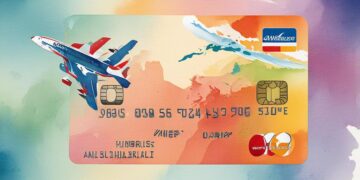Differences Between Cashback Credit Cards and Points Programs

Understanding Cashback and Points Programs
Many consumers are eager to maximize their spending by choosing the right credit card. When it comes to rewards, two popular options stand out: cashback credit cards and points programs. Understanding the differences between these options can help you select the most suitable card for your financial habits.
- Cashback credit cards return a percentage of each purchase as cash rewards.
- Points programs offer points on expenditures, which can be redeemed for various rewards like travel or merchandise.
Both types of rewards come with unique features. Here are some key points to consider:
- Cashback cards typically provide straightforward benefits, making them easy to understand and use. For example, a card that offers 1.5% cashback on all purchases means if you spend $1,000, you’ll receive $15 back as a cash reward.
- Points programs often offer a broader range of redemption options, including experiences and travel perks. For instance, one point may be worth 1 cent toward airfare or hotel stays, translating your spending into meaningful travel experiences.
- Some cards have specific spending categories that yield higher rewards, such as dining or groceries. A card might offer 3x points on restaurant purchases and 2x points on grocery store transactions, encouraging you to use it for these everyday expenses.
Choosing between cashback and points programs depends on your lifestyle and spending habits. If you dine out frequently or travel often, you might find that a points program aligns better with your needs. For someone who values simplicity and wants to see immediate cash benefits, a cashback card may be the ideal choice.
It’s also essential to consider how you plan to use the rewards. Cashback can provide immediate financial relief, while accumulated points may lead to significant savings on your next vacation. Analyzing your spending patterns can help you identify which rewards structure aligns best with your personal goals. This article delves deeper into the differences and benefits of each program, providing you with valuable insights for your decision-making.
Exploring Cashback Credit Cards
Cashback credit cards offer a straightforward way to earn rewards on your everyday purchases. With a cashback card, you receive a percentage of your spending back in cash, either as a statement credit, direct deposit, or a check. This system appeals to many consumers because it is easy to understand and manage. For instance, if you have a card that provides 2% cashback on all purchases, spending $500 will grant you $10 back. It’s like receiving a discount on every purchase you make, which can quickly add up over time.
Additionally, cashback cards often come with no annual fee, making them accessible for individuals who want a reward without additional costs. Many of these cards do require a good credit score to qualify, which is important to keep in mind during your application process. Moreover, some cashback cards offer promotional rates, giving a higher percentage for specific categories such as groceries or gas. It’s common to see cards providing 5% cashback on selected categories that rotate quarterly, allowing you to maximize earnings when you choose the right card based on your spending habits.
Understanding Points Programs
On the other hand, points programs provide an alternative reward structure that can be significantly beneficial for those who travel frequently or prefer redeeming points for various products and experiences. With these cards, you earn points for each dollar spent, which can later be redeemed for items like flights, hotel stays, or even goods from partner retailers. For example, earning 1 point per dollar spent and redeeming those points at a value of 1.25 cents each means that 10,000 points could represent $125 worth of benefits.
One distinct advantage of points programs is their flexibility. Many credit cards offer partnerships with airlines and hotels, creating opportunities for larger rewards during travel seasons. This can significantly enhance the value of your points compared to traditional cashback. Also, points may accumulate faster if you’re spending in categories that offer bonus points, such as dining or travel expenses. You might find a card that rewards 3 points per dollar spent on travel-related purchases, allowing your points balance to grow quickly when traveling.
However, the complexity of points programs can be daunting. Understanding the value of points, knowing how to redeem them effectively, and keeping up with various partnerships and promotions are essential to maximizing your rewards. This can sometimes be a barrier for clients who prefer straightforward cashback options.
Key Takeaways
- Cashback credit cards provide immediate rewards in cash, typically with straightforward rules.
- Points programs may offer higher potential value through travel rewards, but require a more detailed understanding of redemption options.
- Assessing your spending habits and redemption preferences will help clarify which type of credit card aligns best with your lifestyle.
Comparing the Value of Rewards
When deciding between cashback credit cards and points programs, it’s essential to consider how each aligns with your personal spending patterns and reward usage. The perceived value of rewards can differ significantly between the two options. Cashback rewards, being direct and easy to quantify, often feel more satisfying. Since you’re essentially receiving a discount on your purchases, it’s straightforward to see the return on each dollar spent. Whether you choose to apply your cashback toward your bill or save it for leisure activities, you instantly realize its value.
Conversely, points programs can potentially provide more lucrative rewards, especially for those who travel or make significant purchases. The ability to redeem points for flights, hotel upgrades, or experiences can exponentially increase their value. For instance, a flight that typically costs $300 may only require 25,000 points if you choose the right travel partners and timing. However, this requires diligent planning and an awareness of optimal redemption strategies. Understanding when to book flights or take advantage of promotional deals can significantly impact the effective value you receive from your points.
Impact of Redemption Flexibility
The flexibility associated with points programs also extends into how rewards are used. Many credit cards with points systems partner with various travel companies, allowing users to transfer points to airline frequent flyer programs, often at advantageous rates. For example, transferring 1,000 credit card points could yield 1,250 airline miles, which can offer greater overall travel benefits. This aspect appeals to frequent travelers looking to maximize their rewards and stretch them further.
In contrast, cashback cards typically do not offer such options. While you can use your cashback for virtually any purchase or expense, there is no potential for maximizing its value through strategic spending or redemptions. This can be limiting for consumers who are looking for more adventurous or valuable experiences.
Annual Fees and Card Benefits
An important factor to consider when comparing these two types of cards is the associated costs. While many cashback credit cards are available with no annual fees, points programs often come with fees that can range from $95 to several hundred dollars. It’s crucial to analyze whether the perks associated with a points card—such as travel insurance, purchase protection, and exclusive access to events—justify the expense compared to the simplicity of a no-annual-fee cashback card.
Additionally, signing bonuses can sway your decision significantly. Many points programs offer substantial sign-up bonuses—sometimes enough to cover a round trip flight if you meet a minimum spending requirement within the first few months. Evaluating these bonuses against potential cashback offers can further illuminate which card may serve your individual needs best.
Making the Right Choice
Ultimately, the choice between cashback credit cards and points programs boils down to personal preferences and spending habits. For those who prioritize simplicity and immediate rewards, cashback cards are likely the better choice. However, if you’re willing to navigate a more complex rewards landscape, points programs may yield greater benefits, especially for travel enthusiasts. Careful consideration of your spending habits and ultimate goals will guide you to the card that best suits your lifestyle.
Final Thoughts on Cashback Credit Cards vs. Points Programs
In conclusion, understanding the differences between cashback credit cards and points programs is crucial for making an informed choice that aligns with your financial lifestyle and goals. Cashback cards offer a straightforward way to earn rewards on everyday purchases, giving you immediate gratification through tangible savings that can be easily applied to your bills or saved for future expenses. Their simplicity makes them especially appealing for those who do not want to complicate their finances with intricate reward systems.
On the other hand, points programs can unlock more significant rewards, particularly for individuals who travel frequently or make considerable expenditures. By effectively leveraging points through strategic planning and optimal redemptions, you can potentially enjoy enhanced benefits that far exceed the value of cashback rewards. However, this approach requires diligence in understanding the rules, partnerships, and timing involved.
As you navigate these options, consider your personal spending habits, lifestyle, and what you hope to gain from your rewards. If you value flexibility and enjoy travel, points programs might be your best bet. Conversely, if you prefer simplicity and direct rewards, a cashback card could be the right choice for you. Ultimately, the key is to select a card that not only fits your financial needs but also enriches your overall purchasing experience.

Linda Carter is a writer and financial expert specializing in personal finance and investments. With extensive experience helping individuals achieve financial stability and make informed decisions, Linda shares her knowledge on the Territorio Deficiente platform. Her goal is to provide readers with practical advice and strategies for financial success and smart investments.






